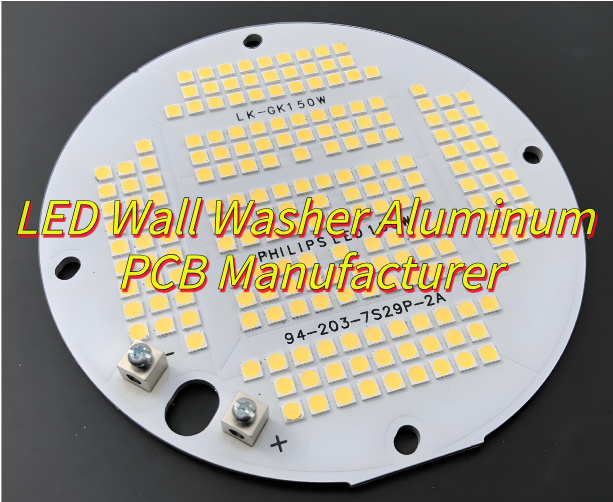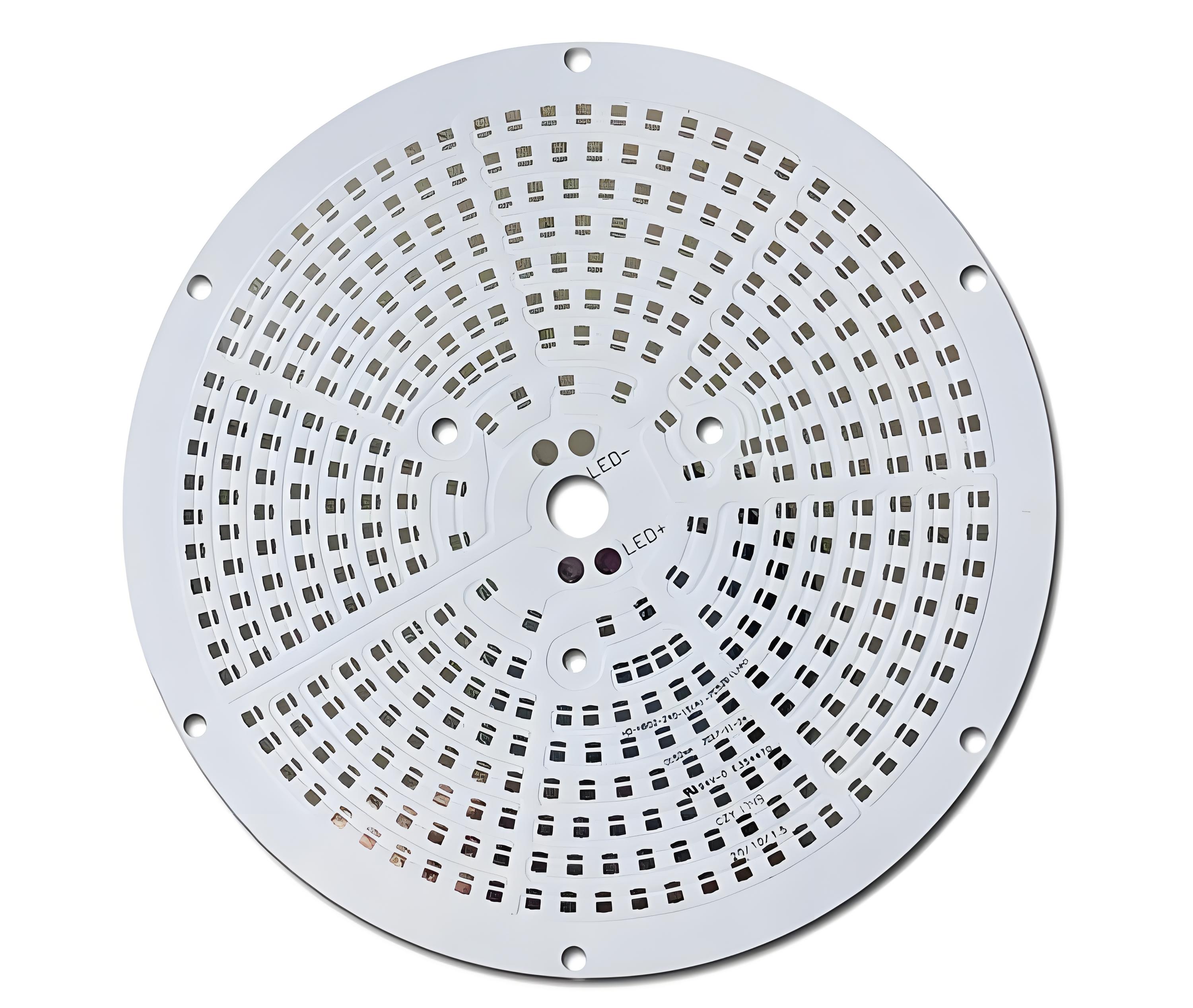Why choose LED wall washer aluminum PCB? Let’s explore its benefits, technical parameter, thermal solution, design guide, selection guide through this blog.
Are you troubled with these problems?
- Poor heat dissipation leads to rapid light decay and short product lifespan?â
- Outdoor environments cause PCB corrosion and oxidation?â
- Heavy wall washer fixtures warp during installation?â
Best Technology can provide services and solutions:
- Custom Thermal Designâ â Optimize aluminum PCB thickness and copper layer layout for precise temperature control.
- Environmental Testingâ â Provide third-party certification for waterproofing, shock resistance, and outdoor durability.
- Fast Prototypingâ â 24-hour turnaround for aluminum PCB samples, accelerating R&D cycles.
Welcome to contact us if you have any inquiry for LED wall washer aluminum PCB: sales@bestpcbs.com.
Why Choose LED Wall Washer Aluminum PCB?
Reasons why choose LED wall washer aluminum PCB:
- Efficient heat dissipation and stable operation: The aluminum base plate quickly dissipates heat, preventing LED damage from high temperatures, ensuring long-term stable operation at high power levels and significantly delaying lumen degradation.
- Lower cost and high cost-effectiveness: Aluminum’s low cost and inherent heat dissipation eliminate the need for external heat sinks, significantly reducing material and assembly costs.
- Lightweight and compact, saving space: High heat dissipation efficiency allows for a thinner and lighter luminaire, eliminating the need for additional heat sink components and enabling flexible installation in confined locations.
- Increased lifespan and reduced maintenance: Temperature control extends LED lifespan to over 30,000 hours, reducing maintenance requirements for outdoor applications at high altitudes.
- Weather-resistant and resistant to harsh environments: The aluminum base plate is impact- and vibration-resistant, and the die-cast housing achieves IP67 waterproofing, making it suitable for outdoor use in the sun and rain.
- Environmentally friendly and recyclable, in line with current trends: Aluminum is non-toxic and 100% recyclable, with low energy consumption in production, meeting green manufacturing requirements.
- Supporting high power density: Carrying high current density, it drives densely packed, high-brightness LEDs for uniform, powerful wall-washing lighting.

LED Wall Washer Aluminum PCB Technical Parameter
| Parameter Categoryâ | âTechnical Specifications | Descriptionâ |
| Base Materialâ | Aluminum alloy (5052/6061) | Thickness: 1.0-3.2mm, with anodized surface treatment |
| Thermal Conductivity | Conductivity: 1.0-8.0 W/(m·K) | Standard type (1.0-2.0) for medium-low power, high-conductivity (3.0-8.0) for high-power applications |
| Insulation Layerâ | Thickness: 50-200ÎŒm | Epoxy resin with ceramic filler, slightly higher loss than FR-4 |
| Dielectric Constant: 4.5-5.0 (1GHz) | ||
| Dielectric Strength: â„3 kV/mm | ||
| âThermal Resistance | Total thermal resistance: 0.8-3.0°C/W | Depends on copper foil area and insulation layer thickness |
| Interface resistance: <0.5K/W (eutectic soldering) | ||
| âElectrical Parameters | Operating voltage: AC220V/DC24V | Suitable for outdoor environments |
| IP65 protection Operating temp: -40°C to +60°C | ||
| âMechanical Properties | Dimensional tolerance: ±0.1mm (custom modules) | Minimal impact from anodizing |
| Surface roughness: Ra 0.2-0.8ÎŒm | ||
| âProcess Standards | Copper foil thickness: 35-70ÎŒm | Compatible with SMT and reflow soldering |
| Peel strength: 1.0-1.5 kgf/cm UL94 V0 flame retardancy |
How Aluminum PCB Enhances LED Wall Washer Light Efficiency?
1. Superior Thermal Management for Optimal LED Operation
- Heat Dissipation Efficiency: Aluminum PCBs (thermal conductivity 1-10 W/m·K) outperform FR4 (0.3 W/m·K) by 10x+, rapidly conducting 70% of LED-generated heat away from chips.
- Temperature Control: Low thermal resistance (0.05â0.2 K/W) enables safe operation at >10W/chip, reducing junction temperature by 10â15°C and minimizing light decay.
2. Electrical Performance Optimization
- Conductivity Advantage: Aluminumâs low impedance cuts power loss, improving system efficiency.
- Light Output Boost: White-coated PCBs enhance reflection efficiency by 30%+, indirectly reducing energy consumption per lumen.
3. High-Density Design Support
- Compact Integration: Aluminum substrates allow higher LED density (e.g., 500+ LEDs/mÂČ) with uniform light distribution, ideal for large-scale illumination.
- Mechanical Reliability: High bending strength prevents solder joint failures under vibration or thermal stress.
4. Cost & Lifespan Benefits
- Extended Lifetime: Thermal efficiency extends LED lifespan to 50,000+ hours (2â3x longer than standard solutions).
- Simplified Design: Eliminates 40% of external heat sinks, reducing material costs and assembly complexity. Aluminum recycling aligns with sustainability goals.
5. Real-World Application Advantages
- High-Power Models: 48W wall washers leverage aluminum PCBs for compact IP66-rated designs, avoiding thermal failure.
- Optical Optimization: Multi-layer structures (LED â phosphor â resin â reflective layer) maximize light extraction while efficiently managing internal heat.

Wall Wash Light Aluminum PCB Thermal Solution
Copper Layer Thermal Design Optimization
- Prioritize solid plane copper layers for maximum thermal conductivity (highest cost).
- For cost-sensitive designs, grid patterns offer 80-90% thermal efficiency with ~10% cost reduction.
- Avoid star/custom patterns unless required for EMC compliance (70-80% efficiency, unstable cost-benefit).
Thermal Via Design Refinement
- Thermal vias are critical for heat transfer from component pads to aluminum substrate. Optimize parameters (diameter, pitch, copper thickness) to minimize thermal resistance.
- Parallel thermal resistance network modeling simplifies design and improves efficiency by 20-30%. Reducing via pitch and increasing quantity is effective but requires cost-balance with drilling.
System Thermal Resistance Reduction
- High-thermal-conductivity substrates: Use aluminum oxide (AlâOâ) substrates (22-24 W/mK), outperforming FR-4/ceramic alternatives.
- Thin dielectric layers: Minimize thickness while meeting electrical insulation requirements (key to low thermal resistance).
- Reduce non-thermal vias: Excessive standard vias increase thermal path length and resistance.
Component Layout & Routing Strategies
- Placement: Avoid hotspots by dispersing high-power components (LEDs, drivers). Position major heat sources near substrate edges or directly over thermal vias. Aim for uniform distribution.
- Routing: Minimize long/thin copper traces to reduce resistive heating. Widen copper traces or increase thermal via contact area in critical paths (15-20% local thermal improvement).
Integrated Thermal Enhancement Measures
- Heat sinks: Most common passive solution, handling ~70% of total heat load. Cost-effective and easy to integrate into housing.
- Forced air cooling: Adds ~85% efficiency in enclosed/high-power units but increases cost, noise, and complexity.
- Thermal interface materials (TIMs): Thermal grease/pads fill micro-gaps, improving interfacial conductivity by ~30% at low cost.
- Liquid cooling: ~95% efficiency but highly complex and costly. Reserved for extreme power densities or specialized applications.
Convection Optimization
- Component orientation: Align temperature-sensitive/heat-generating components with their long axis perpendicular to airflow in natural/forced convection.
- Expose aluminum substrate: Directly expose large PCB aluminum areas to airflow where structurally feasible.
- Airflow management: Arrange tall components parallel to airflow to reduce turbulence and avoid downstream thermal dead zones.
Substrate Material Selection
- Aluminum-based PCBs (MCPCBs): Preferred for wall washers due to excellent thermal performance, mechanical robustness, CTE matching (reduces solder joint fatigue), and recyclability. Thickness range: 0.4-6.0mm.
- Alumina ceramic substrates: Suitable for high-temperature/high-reliability applications (350-1500°C resistance) with good thermal conductivity.
Thermal Simulation Utilization
- Use finite element analysis (FEA) in design phase to predict temperature distribution and identify hotspots.
- Simulation-driven optimization reduces post-development thermal issues by 20-30%, lowering risk and cost, especially for mass production.
LED Wall Washer Aluminum PCB Color Consistency Design Guide
1. LED Selection & Color Parameters
- Color Tolerance (SDCM): Use SDCM â€5 LEDs to ensure batch consistency.
- Color Rendering Index (CRI): Prioritize Ra â„80 LEDs (e.g., Lumileds LUXEON) for accurate color reproduction.
- Dimmable Options: Support 1900K-5700K CCT ranges with SDCM â€5 across all settings.
2. Aluminum PCB & Thermal Design
- Material: High-thermal-conductivity 6063 aluminum (â„200W/m·K) with anodized coating.
- Layout: LED spacing â„20mm (adjust per power) to prevent localized overheating.
- Wiring: 45° traces (width â„0.5mm, spacing â„0.3mm) to minimize current interference.
3. Optical System Optimization
- Mixing Distance: Short-distance lenses (â€15mm) for RGBWY uniform blending.
- Lens: Optical-grade PC/PMMA (transmittance â„92%) with recessed design (depth â„5mm).
4. Environmental Adaptability
- Protection: IP65/IP66 with silicone sealing (e.g., Dow Corning 7091).
- Temperature: Operate from -20°C to +60°C without deformation.
5. Production & Quality Control
- Supplier Collaboration: Verify PCB color process (UV-resistant ink, reflection â„85%).
- Inspection: Tighten tolerances (PCB size ±0.1mm, pad alignment ±0.05mm).
- Soldering: Through-hole preferred; SMT requires epoxy reinforcement.
6. Control System Compatibility
- Dimming: DMX512 0-100% smooth control with Îu’v’ â€0.005.
- Driver: PF >0.9, ripple â€5% (e.g., PFC circuit design).
7. Long-Term Reliability
- Testing: 50,000-hour LM-80 validation, Îu’v’ â€0.003 post-aging.
- Coating: Acrylic varnish (50-80ÎŒm) for UV/chemical resistance.

LED Wall Washer Aluminum PCB Selection Guide
1. Thermal Performance Priority
- Thermal Conductivity: 1.0-2.0 W/(m·K) for low-power (<50W) â„3.0 W/(m·K) for high-power (>50W).
- Substrate Thickness: 1.0mm (lightweight) or 2.0-3.0mm (heavy-duty cooling).
- Construction: 6061 aluminum base + ceramic-filled insulation for low thermal resistance.
2. Electrical Safety Standards
- Protection: IP65 dust/water resistance mandatory for outdoors.
- Insulation: Dielectric strength â„3 kV/mm, copper foil adhesion â„1.0 kgf/cm.
- Voltage: Match input (AC220V/DC24V) with driver compatibility.
3. Optical Compatibility
- Beam Angle: 120° standard lens requires PCB layout alignment.
- Color Quality: High CRI (Ra>90) needs low-decay LEDs.
- Efficacy: â„10 lm/W for white light; RGB requires independent control zones.
4. Mechanical & Environmental Durability
- Coating: Anodized + conformal coating (humidity/mold resistance â€Class 1).
- Impact Resistance: Die-cast aluminum housing (IK10 certified).
- Temperature Range: -40°C to +60°C operational certification.
5. Cost & Supply Chain
- Material Efficiency: Smart panel layout reduces waste by 23%.
- Packaging: SMT-compatible reel packaging recommended.
- Certifications: UL94 V0 flammability rating + RoHS compliance.

Why Choose Best Technology as Aluminum PCB Manufacturer?
Reasons why choose us as LED wall washer aluminum PCB manufacturer:
1. Premium Quality Assurance
- Material Selection: Use 6063/6061 aluminum with thermal conductivity â„150W/m·K (3x higher than industry average).
- Certifications: UL, RoHS, and IP65 compliance guaranteed for harsh outdoor environments.
2. 19 Years of Industry Expertise
- Specialized Experience: Dedicated focus on LED lighting PCBs since 2005, with 500+ wall washer projects completed.
3. Cost-Effective Solutions
- Price Advantage: 15-20% lower than competitors via optimized production lines and bulk material procurement.
- Design Optimization: Free DFM reduces material waste by up to 25% without compromising performance.
4. Fast Delivery
- Lead Time: 24 hour rapid prototyping, 5-7 days for mass production (50% faster than industry standard).
5. Free DFM Support
- Pre-Production Analysis: Identify thermal bottlenecks, electrical risks, and assembly issues pre-manufacturing.
- Design Adjustments: Optimize LED layouts for 30% higher lumen density while maintaining thermal safety.
6. Stringent Quality Control
- Thermal cycling (-40°C~+125°C, 1000 cycles).
- 48-hour burn-in test for all batches.
- AOI/X-ray inspection for solder joint integrity.
7. Customization Capability
- Flexible Design: Support ultra-thin (0.8mm) to heavy-duty (3.2mm) substrates.
- Special Coatings: White solder mask for 95% reflectivity, anti-sulfur treatment for coastal areas.
Welcome to contact us if you have any request for LED wall washer aluminum PCB: sales@bestpcbs.com.


